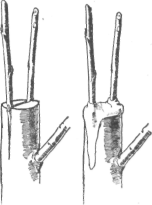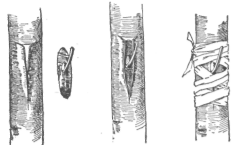GRACES, THE 789 GRAFTING
Description
This page of the book is from "The New Student's Reference Work: Volume 2" by Chandler B. Beach, Frank Morton McMurry and others.
GRACES, THE
789
GRAFTING
for the poor, and one of his first acts was to re-establish the agrarian law. ' But jealousy and deceit were at work, and he was defeated for a third term. Soon the senate began to repeal his laws; he appeared to protest, when a riot occurred wherein over 3,000 of his friends were killed. He was compelled to fly, and escaped to the grove of the Furies with a single slave, where the slave first killed his master and then himself. It was Cornelia, the mother of the Gracchi, who, in answer to a many-jeweled Roman matron's request to see some of her jewels, said, as she presented her sons: "These are my jewels!"
Qra'ces, The ( Greek CharitÚs), the daughters of Zeus and Eurynome, the embodiments of gracefulness and beauty. In Roman mythology they were the three daughters of Venus, by Jupiter or Bacchus, named Aglaia, Thalia and Euphrosyne. Though represented as three sisters, they are always inseparable, and in Greece annual festivals, called Charitesia, were held in their honor. In art they used to be represented as draped, but afterward appeared as nude figures in the bloom of early youth.
Qrack'le. See Blackbird. Qra'dy, Henry Woodfin, an eloquent southern orator, editor of the Atlanta (Ga.)
Constitution, was born at Athens, Ga., in 1851, and died at Atlanta, Dec. 23, 1889. He was educated at the University of Georgia and at the University of Virginia, and devoted himself to journalism. His addresses made him widely known, as they were characterized by an impassioned patriotism which explains his popularity in the south. His two best-known addresses dealt with The New South and The Future of the Negro; the former was delivered before the New England Society. A biography of him was written, by Joel Chandler Harris.
Graft'ing, a process of plant-propagation in which a bud-bearing portion of a desirable variety is made to grow on another plant, so as to take advantage of the more or less well-established root-system of the latter. Graftings can be made only on plants of the same or very similar species, such as apple-quince or plum-peach combinations. The fruit of the part engrafted is like that of the tree it came from rather than like that of the stock.

HENRY W. GRADY
Different methods are budding, stem and root-grafting.
Budding is a method in which a mature bud of a desirable variety is grafted on another plant by slipping it through a cut in the bark of the stock, preferably a young seedling. Budding is used when the plant is so valuable that every available bud is used for a separate plant; stem-grafting, when a tree proves a disappointment on coming into bearing; root-grafting is the usual process used by nurserymen, In stem-grafting, also called
cleft-grafting, from the method, branches about one inch thick are cut off squarely and split; into this cleft two twigs are fastened so as to be in contact with the growing tissue next the bark, and the whole stump is waxed over. Not more than one fourth of a tree should be so treated in one year, and then just before the buds open. In grapes the process is modified by cutting off the stem near the ground. In root - grafting, the stock is a yearling seedling, not much larger than the scion, as the twig is called. The seedling root may be cut into several pieces, each a few inches long. Both scion and stock are cut off diagonally and split, joined and bound firmly together. This is done in the fall, after which the graft is allowed to heal together in moist sand through the winter, and is set out in the spring. Fruit trees must be propagated in this way because their seeds do not breed "true," as do grains, but tend to revert to the wild

GRAFTING

BUDDING


